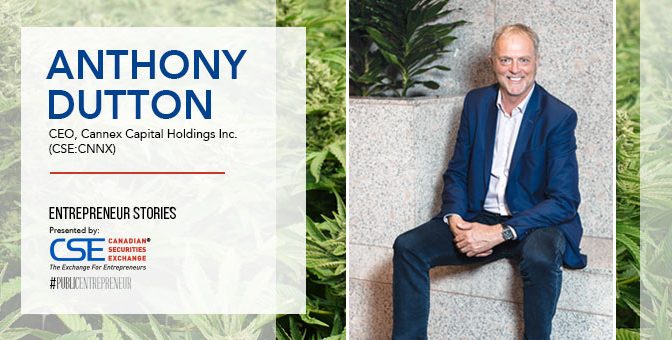Brayden Sutton is one of the pioneers of the modern Canadian cannabis industry and is also fast becoming an authority on the business in the United States, where he believes resources are currently better deployed in most cases. Public Entrepreneur spoke with Sutton, Chief Executive Officer of Friday Night Inc. (CSE:TGIF), recently about the different outlooks for the two markets.
We’ll get into the US regulatory environment around cannabis and your opinions on cannabis stocks in a moment, but first can you explain what Friday Night does and why you chose the US market as your focus?
Friday Night’s primary asset is the very first cultivation license for cannabis in Las Vegas. We bought this asset early in 2017 and took it public in June of that year. It was July when things went recreational, and since then we’ve experienced very good growth. It was all a function of making sure we were ahead of the trends, not chasing them.
I’ve always been one to go where the puck is going to be, not to follow others. I was a first mover on the investment banking side of the cannabis space with my own capital in 2013, and then in cultivation and later in various forms of extraction and processing. I have been fortunate to be able to get in front of trends and I knew that Las Vegas was going to be a great market to be in.
One staggering statistic is that the US cannabis market is estimated to be over $75 billion, and yet not one group controls even 1% of that market. Now that is the opportunity of a lifetime for investors. I was personally invested over 10 years ago in the Canadian cannabis industry, as the MMAR (Medical Marihuana Access Regulations) eventually gave way to the MMPR (Marihuana for Medical Purposes Regulations), and I co-founded Supreme Pharmaceuticals in early 2014.
I began to feel that from 2014 to 2017 things had become stretched on the Canadian side. Canada has a very limited market in all aspects. Despite it leading the world in capital for cannabis initiatives, there are only about 7 million cannabis users coast to coast, so it is a tiny market versus a state such as California or somewhere such as Las Vegas, regardless of whether you are talking adult use or medical.
I know the company has holdings in businesses outside cultivation. Can you talk about those as well?
We own 91% of a company called Infused Manufacturing, which operates as Cannahemp, and they are solely a hemp-derived CBD business. It doesn’t come with the same restrictions and the products appeal to a much broader base. From tinctures and creams to bath bombs and lip balms – there is a very impressive list of products that apply to far more people than cannabis does on its own.
More recently we have acquired Spire Secure Logistics, a Canadian company focused on due diligence and security in the cannabis sector. That branches us into exposure to Canada and once again a growing trend – there is a major lack of discussion around infiltration of organized crime, diversion of product, internal theft of product, products making it into stores when they should not be there, and many, many other issues. It gives us a magnifying glass into the operators we are considering and the ones we have in terms of ensuring we are only working with top-notch business people who put shareholders first – and as important, don’t bring with them any negative history.
What are some of the unique aspects of operating in the US market and how do you make the most of them?
One big one is the opportunity today. With Canada, everyone took at face value Prime Minister Trudeau’s promise of legalization by July, which will not happen. It remains to be seen if it will even happen this year.
If you go south of the border, however, you’ve still got many federal catalysts to come. I would argue that Canada has had its primary growth in the space already from 2013 through 2017 as far as investment is concerned. Now it’s all about market share and who will ultimately shake out as the “Big 5” to serve a recreational market and a much less fragmented medical market. It is much like when people buy a stock on the rumour and sell when the news comes out. In Canada, I feel if cannabis were to become legal tomorrow a lot of people would sell on that catalyst and look for the next big thing. That’s the nature of venture capital; it gets bored easily and needs new opportunities and to blaze new trails.
Just recently there was a conversation between President Trump and the Governor of Colorado, which sent US cannabis stocks higher. There is so much to look forward to and I really see America today much like Canada was in 2013 in terms of the financial opportunity that exists right now. It has years of accelerated growth ahead, and as people wonder if they have seen the peak, it just continues to get bigger, as it did in Canada for the last five years.
As far as operating in the US, I have enjoyed it and our partners municipally and locally are far better to deal with than Health Canada in every way. There is much more of an entrepreneurial mindset in the US. It’s just a lot more enjoyable of an environment, and people seem to be more accommodating to this business, be it construction companies or bankers, they all seem to be happier to have the business. My experience in Canada was people were more hesitant and unsure of the muddy legal landscape. In Nevada, it’s black and white.
Observers are aware of the conflicting positions of US state governments and the federal government. How does that environment get reflected in your corporate strategy?
What if the United States suddenly voted on a rescheduling of cannabis this year or next? Something to consider. Big Pharma spends more money lobbying than any other industry in the US, by far. Big Pharma has an interest in not missing the boat.
Just take Merck, Ely Lilly and Pfizer as examples. Think of the money they are losing every day because this drug is Schedule 1 (no currently accepted medical use in treatment) and not Schedule 2 (has a currently accepted medical use). There is going to be a major push from them and it is already happening behind the scenes. I continue to be of the opinion that we may see more federal catalysts in the US before we do in Canada and for that reason as a company we are very much focused on Nevada and we are fairly confident in an overall softening on the Federal stance, allowing the sector to mature further.
So to answer your question, on a state versus federal level we very much enjoy where we are and are perfectly happy to paint within the lines of the state. One thing I admire very much about the US is the Tenth Amendment and individual states’ rights, and with that we are very confident in our strategy that we will be able to take full advantage federally, once able to do so.
What is the difference between doing business in the various states? Why would you choose one jurisdiction over another?
Nevada has been extraordinarily regulated for decades, and it has to be for things like gambling. Compare Nevada to other states; Washington has thousands of cultivation licenses, as does California, as does Oregon, as does Colorado. Nevada has less than 200.
Colorado legalized the plant in 2014 and the cartels involved in trafficking cannabis moved back into the state because there was an economic point at which they could still be in business. So the state was forced to lower taxation by a couple of dollars per gram and immediately the economics shifted for organized crime and they left.
Nevada was forward-looking in saying they want to ensure illegal players are pushed out and that their new licensees are not going to be underwater in 12 months. I would point to Canada again, where we have over $15 billion of market cap making up the public companies in the space, never mind the private ones, and they are fighting over a total market share of only about $200 million a year in business right now. To me, that represents a bubble in the truest sense. Yes, legalization will launch that number to more like $5 billion-plus, but legalization is not guaranteed.
Look at Nevada versus Canada, Canada probably has 50 times the square footage in terms of canopy space and it has perhaps a fifth of the user base. It is just back of the napkin math. If Canada flicked a switch tomorrow and said it was legal tomorrow, what are they going to do with the surplus product? Export to Europe? In one or two years Germany, Australia and other countries will be caught up and won’t want or need imported weed. Canada will not be important at that point from a global supply standpoint.
I still scratch my head and wonder why there are millions of square feet of canopy on the way for a country as small as ours. Particularly when THC will more than likely eventually come from a petri dish, not a flower pot as the trend moves further and further from the combustion of flower to get THC in your body.
From an investor standpoint, anyone owning US assets in any form needs to have a far greater risk profile than one owning only assets in Canada. The general consensus could be said that Canada is safer, but has far more downside than upside, whereas the US is far riskier, but brings much higher upside potential.
Tell us about the feedback you get from investors and financial professionals on the cannabis sector and Friday Night in particular.
Investors are always hungry for the next thing to get excited about – the next catalyst. We have always been focused on revenue and profit. We are currently at a run rate of well over $10 million a year, which I think is notable in less than 12 months of being in business. Shareholders are very picky nowadays and they demand perfection, as they should. But there is no such thing as a perfect company, so all we can do is our best. And right now I would say we are extremely pleased at our progress to date as well as our trajectory and future prospects.
We are always looking to improve. We are looking at vertical integration, and right now we are looking at owning a strong retail presence, so that is taking a lot of my time, to determine what the best course of action is regarding final sale of the product. Once we are fully vertically integrated we can be exposed to that seed-to-sale margin that so many others enjoy.
There are certain things that are hard to invest in. I am not going to spend CDN$25 million on 20,000 square feet which is the going rate on a Canadian ACMPR grow, when I could spend US$5 million and buy something that is already doing a million dollars a month in sales.
On the banking side and institutional side, they are more pragmatic and see things on a numbers basis. What is our maximum funded capacity, what is the maximum money we can make relative to our current market cap if everything goes as planned, and where would we be in the worst-case scenario? Shareholders tend to be younger, more astute and better educated, but since there is so much misinformation out there, they are looking at it as more of a land grab, which is not the way to look at it. You want to consider if a company is sustainable and profitable many years out, and what they are spending today to get there.
We are generating a million a month and moving towards profitability. All we can do is block out the noise, build value and continue to do what we’re doing. I see a lot of companies buying smaller companies for the sake of owning more companies, mostly due to investors and I think that’s a dangerous strategy long-term.
Any other thoughts you want to leave us with?
I have been an investor for 14 years. When you hold a stock, if you hold XYZ company, you should ask yourself every night when you go to bed if the state or country I am in goes legal, how will I do? If it does not go legal, how will I do? If there is an influx of competitors, how will I do? If key management leaves, how will I do? Just make sure you check all those boxes. If 30 months from now nobody is buying flower, will this company survive? When Merck and Eli Lilly and Pfizer step into the scene, they could literally make this plant obsolete within decades. What I mean by that is that a tiny fraction of the world rolls cannabis and smokes it. But, for example, if and when a 50mg THC/CBD capsule is made for 10 cents in a lab and sold for $5, good luck to the company growing $2 grams and selling it at $6.
So, just make sure that whatever stock you hold does not have any one lynchpin. Know what will happen to that share price in any environment. If someone came along who was stronger and better than me, I would be gone in a heartbeat. I am not a lynchpin for this company. If I ceased to exist tomorrow, the company would still flourish. Those are the type of companies you want to own.
This story was featured in The Public Entrepreneur magazine.
Learn more about Friday Night Inc. at http://fridaynightinc.com/ and on the CSE website at http://thecse.com/en/listings/diversified-industries/friday-night-inc.










